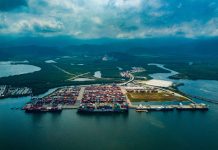
Federal investigators have determined that a single loose wire in the electrical system of the Dali caused the blackout that left the vessel without propulsion or steering before it struck Baltimore’s Francis Scott Key Bridge, leading to its collapse and the deaths of six highway workers.
During a public meeting at NTSB headquarters on Tuesday, investigators explained that the loose wire caused a breaker to open unexpectedly, setting off a chain reaction that resulted in two blackouts as the 984-foot containership approached the bridge on March 26, 2024. They found that wire-label banding prevented the wire from fully seating in a spring-clamp terminal, creating an inadequate connection.
Following the initial blackout, the Dali’s heading swung to starboard toward Pier 17. Pilots and bridge crew attempted corrective maneuvers, but the loss of propulsion so close to the structure left them unable to alter course. A major section of the 2.37-mile-long bridge collapsed into the Patapsco River, with portions of the pier, deck and truss spans falling onto the vessel’s bow and forward container bays.
A maintenance crew of seven workers and one inspector were on the bridge at the time. Six workers were killed. The NTSB noted that swift actions by the ship’s pilots, shoreside dispatchers and the Maryland Transportation Authority to halt traffic likely prevented further casualties.
“Our investigators routinely accomplish the impossible, and this investigation is no different,” said Jennifer Homendy, chairwoman at the NTSB. “The Dali, at almost 1,000 feet, is as long as the Eiffel Tower is high, with miles of wiring and thousands of electrical connections. Finding this single wire was like hunting for a loose rivet on the Eiffel Tower.”





